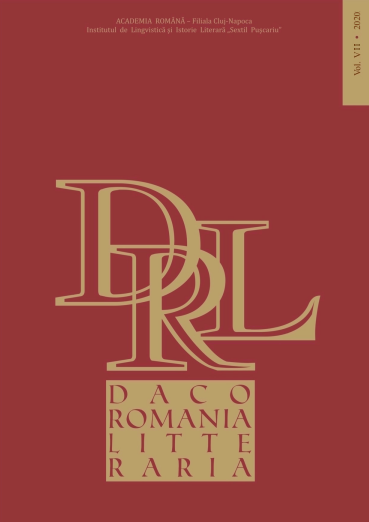LE GHETTO DANS LE ROMAN ROUMAIN DE LʼENTRE-DEUX-GUERRES
THE GHETTO IN THE ROMANIAN INTER-WAR NOVEL
Author(s): Liliana BurlacuSubject(s): Language and Literature Studies, Studies of Literature, Romanian Literature, Theory of Literature
Published by: Academia Română, Filiala Cluj-Napoca
Keywords: marginal space; minority community; ghetto; shtetl; everyday reality;
Summary/Abstract: Two years pass between 1931, when A.L. Zissu, one of the most important representatives of the Jewish community in Romania, voices publicly his doubt regarding the existence of the Romanian-language Jewish literature, and the moment of publication of the volume opening the series of the ghetto-illustrating novels (I. Peltz, Calea Văcărești, 1933). By the time of the political rise of the radicalized right wing, which concluded with the ostracizing of the Jewish community, and, in the cultural sector, with the blacklisting of their literary creation, Foc în Hanul cu Tei [Fire in the Linden Tree Inn] (1934) by the same I. Peltz, Ghetto Veac XX [20th Century Ghetto] by Ury Benador, and Copilăria unui netrebnic [A Wretched Manʼs Childhood] by Ion Călugăru (1936) were published. From the Văcărești Route of Greater Romaniaʼs growing metropolis, through the Jewish neighborhood of an important town by the Danube (Brăila), to “ulicioara Țiprei” in the anonymous Moldavian bourg of Dorohoi, the ghetto novel tends to complete out of time the fresco of the inter-war Jewish community; the scope of this phenomenon can be guessed by looking at the started literary projects, some of them abandoned after the first volume (Ury Benadorʼs trilogy, Ghetto veac XX), some other completed (continuing Copilăria unui netrebnic, Ion Călugăru writes Trustul [The Trust], 1937, and Lumina primăverii [The Light of Spring], 1939). From the very beginning, the frequency of the phrase in the literary text is insignificant, despite the fact that it has been present in the Romanian prose writing since the third decade of the 20th century in two of the titles, at Benador (Ghetto veac XX) and Ludo (Ghettouri [Ghettos]). Here, too, the ghetto refers to its historic meaning of elsewhere, its local pinpointing being challenging; and when referenced, it is done metaphorically, linked with a state of sentimental isolation, at I. Peltz and Ury Benador. By the time of the terrible connotations it would acquire in the following decade, the “ghetto” painted by the Romanian-language Jewish writers would grow perceptively close to what Loïc Wacquant calls the “ethnic neighborhood”, and the idea is backed by a flexibility of its boundaries and an incipient intrinsic cultural diversity. Commitments such as the rejection of the artificial, objectivity, personal experience guide the Jewish writerʼs narrative endeavor in the temporal cut-out of the third decade: overall, the ghetto novel resounds, first of all, owing to its biographic nature, while some other particularities include the “harmony of space”, by keeping the plot within the exclusive perimeter of the ghetto and by anchoring it in everyday life.
Journal: Dacoromania litteraria
- Issue Year: 7/2020
- Issue No: 1
- Page Range: 194-204
- Page Count: 11
- Language: French

